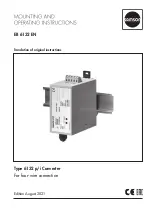
3
3TL
6
6TL
Public grid connection regulations
RD1699/2011, DIN V VDE V 0126-1-1, EN 50438, CEI 0-21, VDE-AR-N 4105:2011-08,
G59/2, G83/2
(6)
, AS4777.2, AS4777.3, IEC 62116, IEC 61727, UNE 206007-1, ABNT
NBR 16149, ABNT NBR 16150, South African Grid code, IEEE 929Thailand MEA & PEA
requirements
(1)
The maximum power of the inverter is a calculation of the battery voltage multiplied by the maximum discharge current (50 A).
(2)
Only possible if there
is no PV energy.
(3)
Never exceed this value. Consider the voltage increase of the panels ‘Voc’ at low temperatures.
(4)
This power will be available if the
battery voltage multiplied by the maximum discharge current reaches said value.
(5)
This parameter can be set on the display.
(6)
For units of more than
16 A.
2.6. Residual current device
The units without a transformer (TL) incorporate a differential circuit breaker which serves to disconnect the unit in
the event of a 30mA differential current.
This residual current device exclusively protects the unit. You must install a residual current device to
protect the installation according to the country’s legislation.
2.7. Description of wiring inlets
Units without a transformer
A
D
B
E
G
F
H
I
J
C
F
Units with a transformer
A
D
B
E
G
F
H
I
J
K
K
C
F
A.
Storage system (PG20).
B. PV array *.
C.
DC switch *.
D. Communications accessories
(PG20).
E.
CAN communication of the
storage system management system
(PG16).
F.
Digital inputs / outputs (PG16).
G. Storage system temperature
sensor PT-100 (PG16).
H. Synchronization input for three-
phase systems (PG16).
I.
Consumption grid (PG25).
J.
Auxiliary grid/genset (PG25).
K. Transformer connection **.
* Optional.
** Units with a transformer.
61
Unit description
Ingeteam
ABH2013IQM01_A - Installation and Operation Manual
DE
EN
ES
FR
IT
PT















































